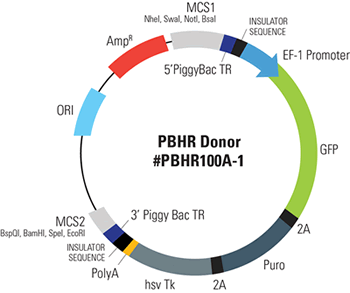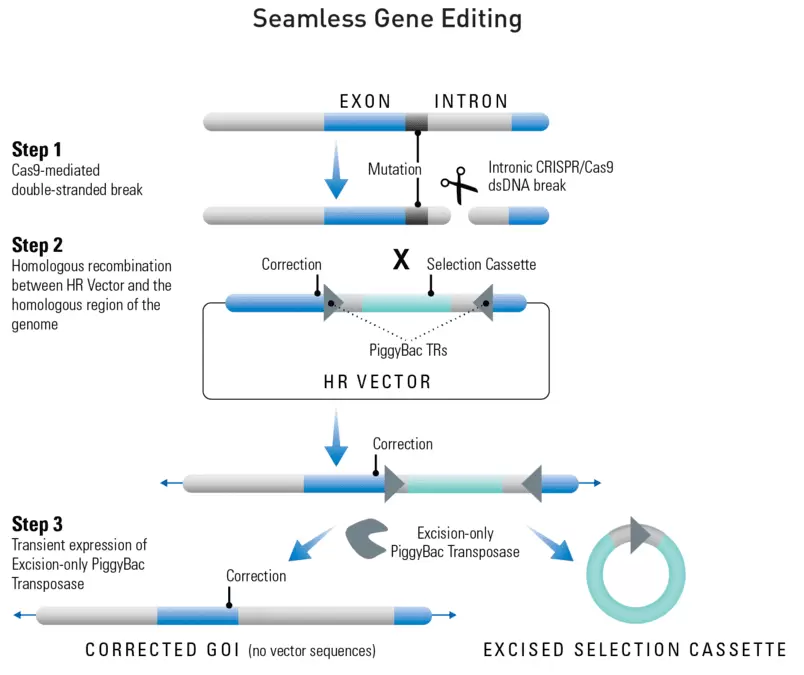PiggyBac-HR with GFP+Puro markers and TK selection [MCS1-5´PB TR-EF1alpha-GFP-T2A-Puro-T2A-hsvTK-pA-3´ PB TR-MCS2] for Gene Correction
Without a trace—make seamless gene edits with no residual footprint—includes dual GFP/puromycin selection and on-target enrichment with TK selection
Product Description
- PiggyBac Gene Editing HR Targeting Vector
- For use with the PiggyBac Transposon System
- Clone your homology arms into MCS1 and MCS2
- Puromycin selection and RFP-positive imaging to find integrants
- Enrich for on-target events using negative thymidine kinase (TK) selection
- Use Excision-only PiggyBac Transposase for footprint-free removal of vector sequences
This special HR Donor works with the Excision-only PiggyBac Transposase instead of the Cre-LoxP system. Simply proceed with your CRISPR/Cas9 gene editing as usual—clone your homology arms into MCS1 and MCS2, use dual GFP and puromycin selection to find integrants, and enrich for on-target events using negative thymidine kinase (TK) selection.

Why use an HR targeting vector?
Even though gene knock-outs can result from DSBs caused by Cas9 alone, SBI recommends the use of HR targeting vectors (also called HR donor vectors) for more efficient and precise mutation. HR donors can supply elements for positive or negative selection ensuring easier identification of successful mutation events. In addition, HR donors can include up to 6-8 kb of open reading frame for gene knock-ins or tagging, and, when small mutations are included in either 5’ or 3’ homology arms, can make specific, targeted gene edits.
How It Works

Figure 1. Seamless gene editing with the Excision-only PiggyBac Transposase.
- Step 1: Cas9 creates a double-stranded break (DSB) in the genomic DNA at a site that is complimentary to the gRNA. For gene editing, this DSB should be within an intron.
- Step 2: The DNA repair machinery is recruited to the DSB. In the presence of an HR Donor with homology to the region adjacent to the DSB (blue areas of the genomic and vector DNA) homologous recombination (HR) is favored over non-homologous end joining (NHEJ). If one of the homology arms of the HR donor contains the gene edit, it will be incorporated into the gene through the HR repair process.
- Step 3: Like the Cre-LoxP system, the PiggyBac Transposon system relies on an enzyme—the transposase—to mediate a site-specific recombination event between two sites, the 5’ PiggyBac Terminal Repeat (TR) and the 3’ PiggyBac TR. However, unlike the Cre-LoxP system, the Excision-only PiggyBac Transposase completely removes the 5’ and 3’ PiggyBac TRs as well as any sequences in between the two TRs. The design of the PiggyBac Gene Editing HR Targeting Vector (MCS1-5’PB TR-EF1α-GFP-T2A-Puro-T2A-hsvTK-pA-3′ PB TR-MCS2) places two homology arms just outside of the PiggyBac Terminal Repeats (TRs). Thus, after Excision-only PiggyBac Transposase activity, all vector sequences are removed.
Customer Agreements
Academic customers can purchase PiggyBac Transposon System components for internal research purposes for indefinite use, whereas Commercial customers must sign a customer agreement for a four-month, limited-use license to evaluate the technology.
For end user license information, see the following:
* SBI is fully licensed to distribute PiggyBac vectors as a partnership with Hera BioLabs, Inc.
- Catalog Number
PBHR100A-1-SBI - Supplier
SBI System Biosciences - Size
- Shipping
Blue Ice

